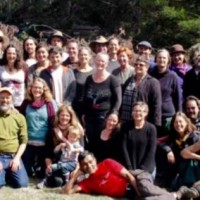Biointensive Urban Farming vs Edible Forest Gardens
Of course, it’s obvious isn’t it, we need both!
I’ve just returned from a 9 day Forest Garden Design Intensive with Dave Jacke… So much information to absorb, and such an eye opening and intensely rigorous method of design.
But let’s start with late February, when I went along to a one day Urban Farming ‘masterclass’ with Curtis Stone. Let’s just say this event blew my mind. It was a kind-of motivational ‘how-to’ guide to be a successful urban farmer. That is, if you have the energy, charisma and motivation of Curtis Stone!!
The urban farming concept is about taking/leasing vacant or otherwise under-utilised land, and quickly turning it into a productive micro-farm, all organically and ethically. It’s not about growing food for a hobby; it asks the question: Can a person use this approach to grow food sustainably and for profit (or a livelihood, at least)? With a simple, clearly laid out system, it appears to be totally doable – if that’s what one wants to do as a day-to-day thing 🙂
So far, I’ve been selling a few greens, figs, herbs etc, to a couple of local cafes, not regular supplies yet… but working on it slowly. Also for the last several months, been managing to produce a veggie box a week, which is sold to one of my regular customers for a bargain $10.
I’m certainly going to be looking at trying to access a little extra land in order to grow intensive crops… If I can work out my ‘goals’, and whether spending that time is worth-while.
But I also want to explore how much surplus might come out of a slightly more ‘intensively managed’ food-forest system – and importantly, it’s the fruits, herbs and perennials that don’t really come out of ‘row crops’. Well I’ve already got part of an answer, because what I’ve been doing at home so far is, more or less, an evolving forest garden system, at various stages of development.

Food Forest – a sea of green. Hopefully in a couple of years it’ll be a sea of fruit!
Getting back to the Forest Garden Design Intensive, a couple (amongst many) of the key take-away points related to design, is that you need to A) Get the goals right. Working out exactly what you (and others) want to achieve is essential before designing a system. B) The design process, including analysis of the site, can be an extremely rigorous process (if you want it to be). Hours spent onsite and researching: Landform, water flows, access patterns, trees, plants, microclimates, infrastructure, soils, aesthetics, etc.
Add just a touch of creativity (and more research), and the design itself should flow from these two steps. Get it right, and we might actually be able to create some incredible, productive landscapes.
Here’s just a brief list of the main topics we covered during the course:
- Gardening Like A Forest
- Guilds & Polycultures
- Ecosystem Succession
- Goals Articulation
- Site Analysis and Assessment
- Design & Implementation
In all, it was an amazing 9 days, and it was great to see how much the ethics of Permaculture was embedded INTO the course itself – the food, the course structure and especially the social aspects of taking a bunch of people who largely don’t know each other, and creating a community of people in that time.
Thanks Dave, and all the other teachers: Steve, Matt, Kat & Speedy.
…
So anyway, I’ll be trying out both approaches, to varying extents, and will definitely report back. Not just which one is ‘more successful’; but rather where each one fits in the landscape of local / urban food production, because I’m pretty sure they both do.
PS – This post is about micro-urban farming on very small areas of land – let’s not forget about market gardens and small local farms too… Plenty of potential there, but that’s a whole different topic as the cost of land, and the slightly further ‘distance to market’ changes the dynamic considerably.
















